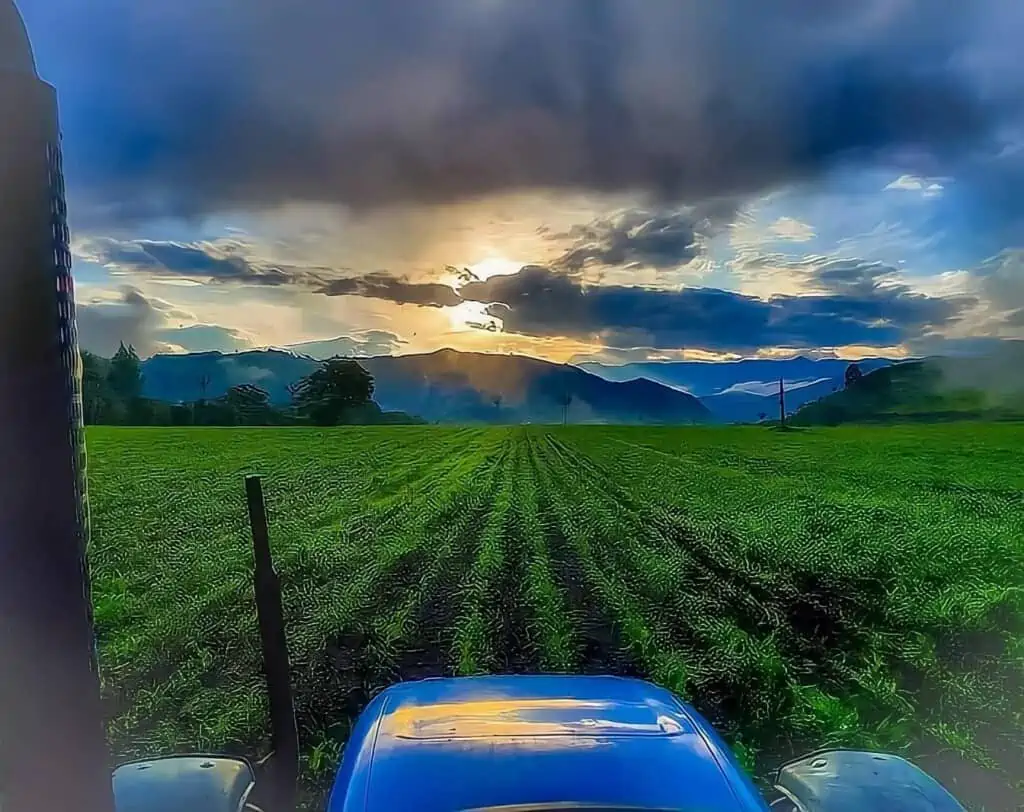
Coffee plants growing at Finca Cruz Loma in Ecuador. Courtesy of Simon Hsieh.
Every few years, we at Coffee Review like to survey the dark roast landscape. Dark-roasted coffee is a daily staple for some coffee drinkers and anathema to others. But there appears to be a sweet spot that appeals to a wide range of coffee-drinking styles that’s not too light and not too dark, making equal space for those who drink their coffee black and those who doctor it with dairy, nut and oat milks, coconut cream, etc. As with everything we consume, personal preference rules, and it was nice to learn, by way of cupping for this month’s report, that there’s a great deal of range offered by today’s darker-roasted coffee profiles.
Of the 14 coffees we review for this month’s report, four were purchased as benchmarks for the darker-roasted category. They include two widely available coffees roasted by Starbucks, and two by Peet’s. Peet’s originated the practice of dark-roasting all coffees, Starbucks spread it worldwide, and both continue to dominate the category in the U.S. As benchmarks, we chose a pair of long-popular dark-roasted old-school blends, Peet’s Major Dickason’s Blend and Starbucks’ Pike Place Blend, and two dark-roasted single-origin coffees, Peet’s Kenya Auction Lot and Starbucks’ Sumatra Dark. Our effort here was to review popular large-roaster parallels to the darker roasted blends and single-origins we expected to receive from smaller roasters. (However, all four of the Peets/Starbucks benchmarks are quite dark-roasted compared to half of the highest-scoring coffees, which fall into the medium-dark range. More on that below.)
The remaining 10 coffees we review here fall into two basic camps: classic blends roasted to either medium-dark or dark, and single-origin coffees roasted to either medium-dark or dark. We also asked roasters to reflect briefly on their philosophies about dark roasts and their customers’ roast preferences.
What Does “Dark Roast” Really Mean?
What constitutes a “dark roast” coffee, anyway? At the Coffee Review lab, we use an Agtron near-infrared spectrophotometer, an instrument that identifies degree or darkness of roast fairly precisely and with good consistency. We use the M-Basic “Gourmet” Agtron scale and, for each coffee reviewed, we indicate values for whole beans (the number preceding the slash) and ground beans (the number after the slash). So, a reading of 46/60 would describe a coffee with an external, whole-bean M-Basic reading of 46, and a ground reading of 60. You can read more here, but the following chart gives a good sense of the range of roast levels we see among the darker-roasted coffees reviewed this month, which range in whole-bean Agtron from 32 to 47.
| Roast | Agtron | Characteristics |
| Light | > 70 | Light brown to cinnamon color Lightish body, sometimes muted, sometimes delicately fresh in flavor; green coffee distinctions are clear No oil on surface of bean |
| Medium – Light | 61 – 70 | Moderately light brown color Bright, sweet acidity, green coffee distinctions clear Surface of bean remains dry |
| Medium | 51 – 60 | Medium brown color Balanced acidity, fuller body, green coffee distinctions still apparent Generally dry bean surface |
| Medium – Dark | 41 – 50 | Rich brown color Droplets of oil may appear on bean surface Fruit turns chocolaty, hints of roasty bittersweetness may emerge Green coffee distinctions are muted and transformed but usually still readable Somewhat muted acidity, sometimes heavier body |
| Dark | 35 – 40 | Deep brownish/black color Spots of oil to shiny surface Richly to sharply bittersweet, scorched-wood roast notes prominent Acidity muted |
| Very Dark | 25 – 34 | Black surface covered brightly with oil Bitter/bittersweet tones dominate Body thins, green coffee distinctions are fully muted |
| Extreme – Dark | < 25 | Black, shiny surface Burned bitter tones dominate |
Of course, many small roasters can’t afford expensive Agtron machines. Some may use color charts to roughly gauge roast level by the external color of the coffee beans. But more importantly, roasters are trained in tracking the key stages in the roasting process that reflect the development or darkness of the roast.
Darker Than What?
For this month’s report, in which we review “darker-roasted” coffees, the immediate question to consider is: darker than what? We named our inquiry intentionally to honor the relativity of what “dark” subjectively means to different people. For some, only a shiny-beaned French roast is truly dark, while for others, a coffee that comes within a hair of what roasters call “second crack” is dark, i.e., darker than the lighter-roast styles popular in the third-wave coffee scene.
We wanted to look at the widest range of possible interpretations of “darker-roasted” coffees, but we also needed some parameters to limit scope, so we asked roasters to submit coffees that were roasted to second crack, or beyond. First crack is the stage of the roasting process at which green coffee starts to sound like popcorn popping in the roaster, and it marks the earliest development stage at which coffee can be ground and consumed. After a period of silence, second crack begins, a round of popping sounds softer and gentler than first crack. This is when the cellular matrix of the coffee begins to break down and, eventually, cellulose begins to lightly char. It’s at second crack that most coffees begin to develop characteristics we associate with darker roasts, including deepening caramelization of sugars and notes of overt roastiness like toasted nuts, scorched aromatic wood, or even smoke — all of which can be pleasant or unpleasant depending on one’s taste. In terms of whole-bean Agtron numbers as measured by our instrument, second crack usually starts somewhere around 47. The relationship of a given coffee to second crack is a great dividing line among roasters, with “second-wave” roasters like Peet’s and Starbucks almost always going past it, and “third-wave” roasters, like many of the small specialty roasters active today, almost never letting roasts go that dark, arguing that one risks obscuring the character of the green coffee, including any origin or varietal distinctions.
New Wave Nuance
At least, that’s the stereotype. And like many stereotypes, it’s not necessarily true. In fact, lots of third-wave roasters offer coffees at the lighter end of the “darker” roast range, coffees that the chart above would characterize as “ medium-dark.” So, in terms of our central report question, “darker than what?” they are just slightly darker than a typical medium roast. Of the coffees we review here, these include Hula Daddy’s Pointu Laurina (95; whole-bean Agtron 46), Mostra’s Indonesia Sumatra Kerinci Valley (94; whole-bean Agtron 47), Rusty’s Ka’u (94; whole-bean Agtron 47), Theory’s Dark Side of the Bloom (93; whole-bean Agtron 46), and Red Rock’s Black Magic Blend (92; whole-bean Agtron 46) — that’s exactly half of the coffees we review this month, not counting benchmarks (see below).
We asked these roasters to explain their interest in dabbling around that second-crack demarcation point, the gateway to darkness, and they each had thoughtful reasons to share.
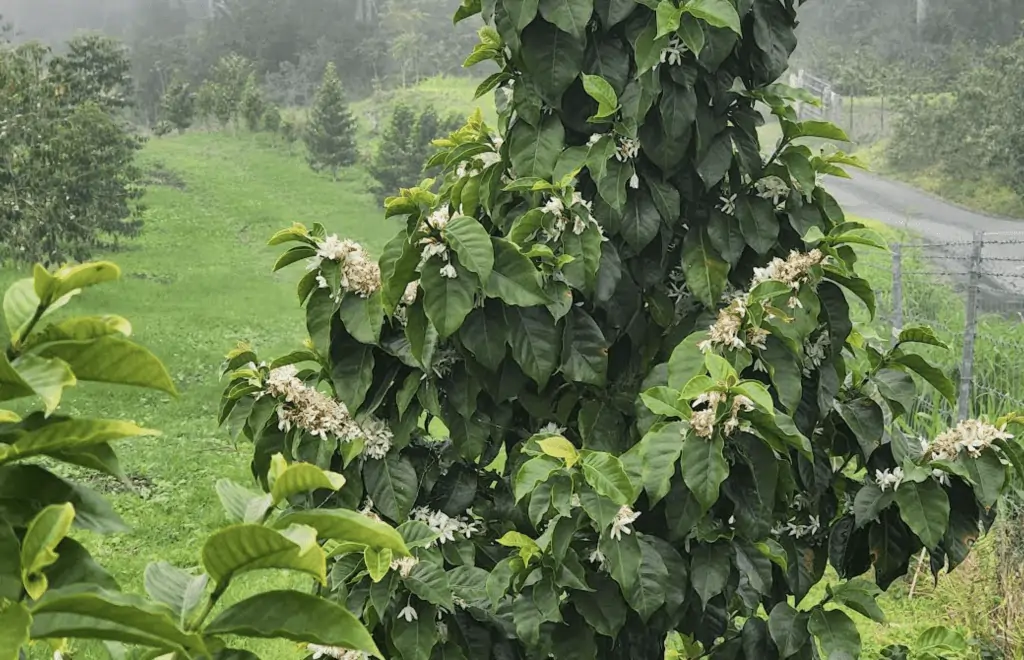
A flowering coffee tree at Hula Daddy’s Kona Farm. Courtesy of Hula Daddy.
Laura Ross, Hula Daddy’s head roaster, says that 30 percent of their sales are medium-dark roasts, and she was interested in developing the popular Pointu Laurina variety, grown on the Hula Daddy Kona farm, to see if she could embolden the mouthfeel. After experimenting with many different profiles, she settled on this medium-dark roast that preserves the character of this rare variety while deepening the mouthfeel. We’ve tasted this rare, naturally low-caffeine variety before as a medium-light roast. This darker-roasted version is rife with distinct notes of dark chocolate, goji berry, gardenia and hazelnut butter, and every bit as worthy as its lighter-roasted counterpart, which we found more citrusy and berry-driven. The side-by side is a lot like comparing 100% Chardonnay from Napa (the darker roast) with a 100% Chardonnay from Chablis (the lighter roast).
Mostra’s head roaster, Nick Berardi, who reports that sales of dark roasts hover between 20 and 30 percent, knew that this Kerinci Valley Sumatra was a good candidate for taking darker. He says, “The cup characteristics of the sample roasts led me to explore modulating the Maillard stage [a roaster’s term for the early browning stage of the roast] pretty widely and combine a few ideas in almost a reverse-sear sort of thing. It doesn’t work for all dark roasts, just the hardier beans.” His roasting philosophy, in general, echoes this approach: “Be adaptive and pull from relevant experiences and resources. If a coffee performs well as both medium and dark, for example, we know that gives us more to play with in a dark roast.” Mostra’s Sumatra is richly chocolaty and sweetly earth-toned with notes of sandalwood, dried black cherry, freesia, marjoram and fresh humus.
Joan Obra, of Rusty’s Hawaiian, says, “The Ka’u Classic Dark Roast is our bestseller in Hawai’i. That’s no surprise because we tested and adjusted its roast profile based on feedback at farmers markets and tastings at local stores. Our goal: to create a lighter profile than locals are used to in a dark roast. We played with different roasts around second crack, until customers would try this coffee with no milk or sugar and say things like, ‘That’s really smooth. It’s dark roast, but not too dark!’” Our own cupping notes include nectarine, brown sugar, wisteria, baking chocolate and fresh-cut oak.
Roaster Joel Lohner, of Theory Coffee Roasters, says, “Dark Side of The Bloom is our tribute to dark roast. We roast and blend four coffees together to achieve the best of both worlds. On the dark side, you will experience a rich, full-bodied coffee with a hint of smoke. On the light side, you will experience all of the complexity that we love in lighter roast coffees. We are really excited and proud of how this blend walks the line.” It represents about 20% of the company’s total sales. The blend is richly sweet-tart and sweetly herbaceous with notes of baking chocolate, tangerine, sage, peach and pipe tobacco.
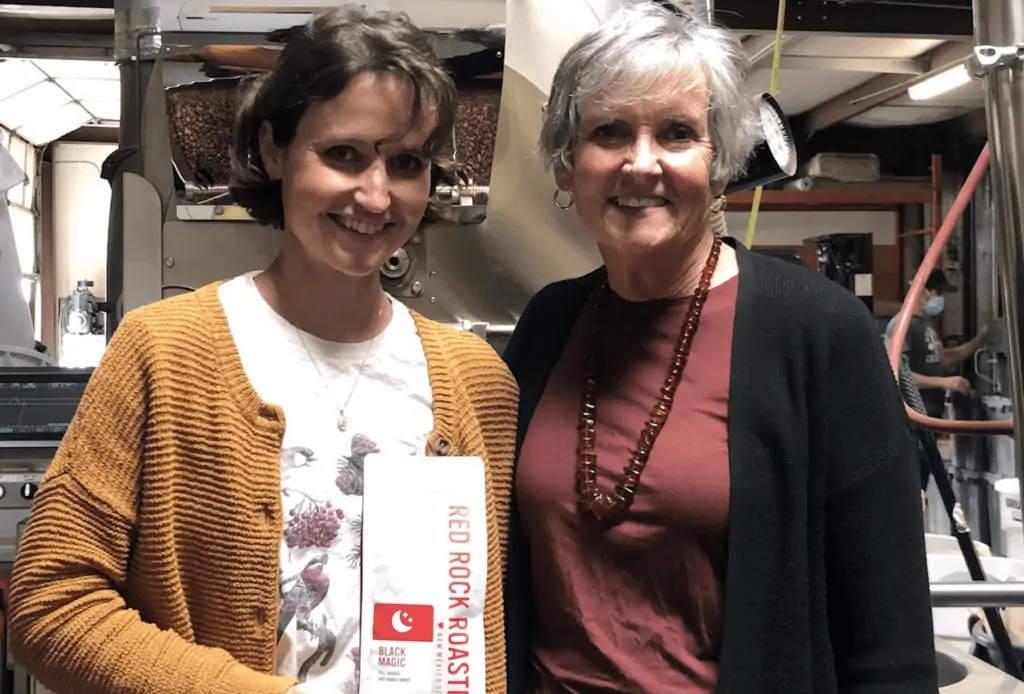
Rachel and Nancy Langer of Red Rock Roasters in Albuquerque, New Mexico. Courtesy of Red Rock Roasters.
Rachel Langer, co-founder of New Mexico-based Red Rock, says of the Black Magic Blend, “About half of our customers choose a dark roast. We hear comments about preference for ‘boldness’ and ‘strong coffee’ and a lot of favorable comparisons to Starbucks for not being burnt. The other day, a new wholesale client had a long vent about how much he hates sour, grassy coffee. My personal philosophy as a roaster is that my job is to create sweetness and enhance aromatics without veering too far into either of those extremes. Sometimes we say we’re painting with a small paintbrush here because we don’t roast super light and we don’t go beyond second crack. Black Magic, our darkest roast, continues a rolling second crack as it hits the cooling pan.”
Langer adds that, as wholesale roaster, she has to consider coffees that go well with food. She says, “Even though I have a personal preference for lighter roasts, from a culinary perspective, I find that darker roasts typically pair better with food, whether breakfast burritos or crème brûlée, because of the stronger dark chocolate ‘hey, I’m coffee’ signals coming from the cup — and because eating food impairs the taster’s ability to perceive nuance in light roasts.” Black Magic is gently roasty, richly chocolaty and nut-toned with notes of dark chocolate, kumquat, roasted walnut, peach and magnolia.
Four Familiar Benchmarks
We include these benchmark coffees as reference points in this conversation about “darker-roasted” coffees, as they are widely available and familiar to many coffee drinkers and provide a sense of how far the other 10 high-scoring coffees from smaller “third wave” roasters have deviated from the darker-roasted “norm” established by companies like Peet’s and Starbucks. Scores and notes are as follows:
Peet’s Major Dickason’s Blend: We rated this longtime Peet’s blend at 87 (whole-bean Agtron, 38) and found this example to be sweet and also quite dry, with notes of scorched fir, cocoa powder, lily and raisin.
Starbucks Pike’s Place Blend: Pike’s Place Blend scored 84 (whole-bean Agtron, 34), is briskly dry in structure with a vegetal sweetness bordering on composty (from poor quality green coffees?) and lingering burnt wood flavors. It’s partly saved by a pleasant carob-like throughline.
Peet’s Kenya Auction Lot: This single-origin Kenya is very dark-roasted (whole-bean Agtron, 38), but nonetheless rated 92 for its still discernible and attractive Kenya character — it’s a little like a very ripe California Cabernet Sauvignon that can take a lot of oak.
Starbucks Sumatra: The darkest-roasted coffee we review here (Agtron, 32), this Sumatra scored 90 for its earthy sweetness and full, creamy mouthfeel.
If these coffees are any barometer of the possibilities of dark roasts, then dense single-origin beans that can withstand lots of heat (and are roasted deftly) can be taken quite dark without forgoing origin and varietal character altogether, while adding roast-related notes that many people enjoy, especially those who drink their coffee in ways other than black. These two single origins would both fare better on the cupping table if a bit lighter-roasted, but pushing them darker has not destroyed them.
Classic Dark Roasts: Four S.O.s & One Blend
Five coffees from small roasters with whole-bean Agtrons of around 40 (the edge between dark and medium-dark) also did well in our cupping, ranging in score from 91-95. Four single origins top this group. The highest scorer overall, Simon Hsieh’s Ecuador Finca Cruz Loma (95), is a decadently rich, resonantly chocolaty dark dream, with enough fruit subtlety and floral finesse to please a wide range of coffee drinkers, and perhaps even shatter some preconceived notions about dark roast coffees for those typically not inclined toward them.
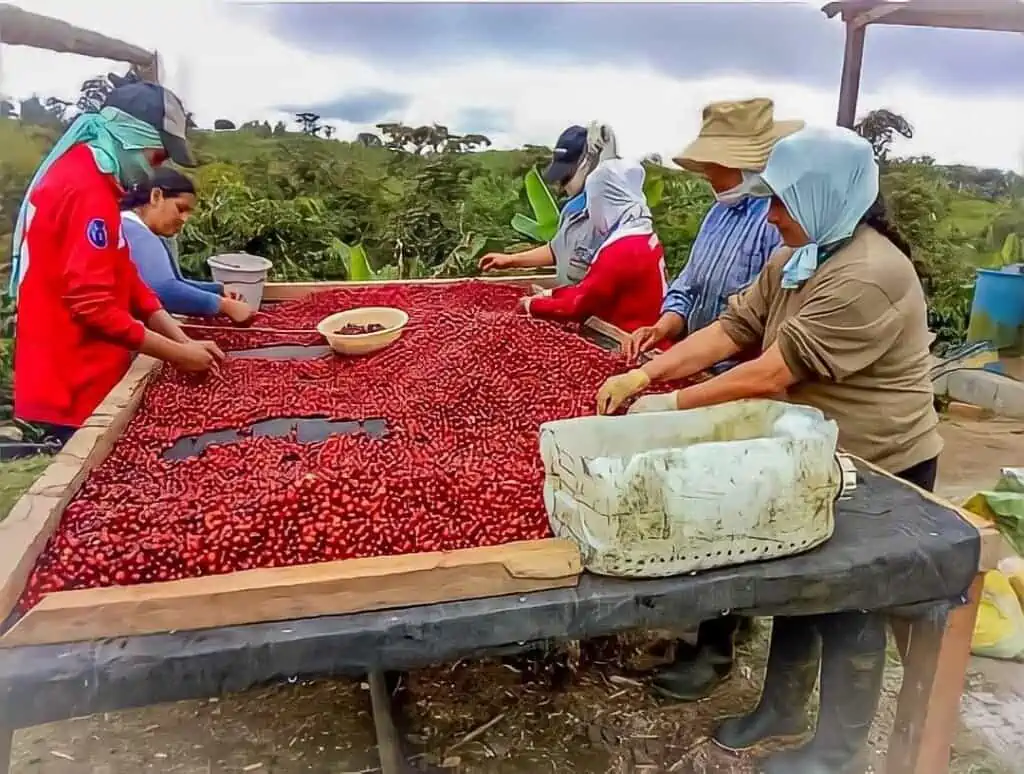
Sorting cherries at Ecuador’s Finca Cruz Loma. Courtesy of Simon Hsieh.
Hsieh has been digging into darker roasts for 12 years, at the direction of his finicky, acid-sensitive stomach. Hsieh’s stomach is happier now that he mutes acidity by roasting darker, and he has become a veritable master of the dark-roast profile. He says, “Only the best green coffees can survive in higher temperatures while still keep tons of wonderful flavors. This one won the Ecuador Taza Dorada championship over several natural- and honey-processed Geishas on the table. It’s great material for darker roasts.”
Likewise, Paradise Roasters’ Aged Sumatra Semiga (94), a uniquely composed coffee that’s anaerobically processed and elegantly funky, is a green coffee that proves it can take a darker roast level. It yields a cup redolent of pipe tobacco, scorched clove, dark chocolate and ripe banana. Owner Miguel Meza says, “We like using aged coffees for dark roasts. While the best ones also make excellent light roasts, at a darker roast, they have a very viscous, oily mouthfeel and mild acidity, characteristics I think consumers enjoy in darker roasts that these coffees can take to extremes while still being at a roast level light enough to not taste charred.”
Overall, about 25% of the coffees Paradise sells are darker roasts. Meza says these coffees are certainly preferred by customers who like to add cream or milk to their coffee, as well as consumers who don’t enjoy the more intense acidity of lighter roasts.
Paradise roaster Sam LaTendre adds that she’s roasted many other aged Sumatras but says this one is different: “I dropped the charge temperature to help prolong the length of the drying a little bit. And then I cut the heat way sooner after first crack. Normally for a darker-roasted coffee, I keep the heat on for quite a while after first crack. But on this coffee, I had to cut the heat almost immediately after first crack, almost as if it were a light roast, so that it would coast a little longer in development.”
Green Stone Coffee’s Jlove99 Kenya (93) displays notes of lavender, red currant, gently scorched cedar, baking chocolate and lemon zest deftly developed by a solid dark profile. Owner and roaster Kelly Wang, whose dark roasts comprise around 40% of total sales, says she first selects a high-quality green coffee with high density and good moisture level, which often leads her to Africa’s high mountain growing areas. She wants her dark roasts to go well with milk so that the fat and sweetness balance the richly bitter tendencies of the coffee.
North Carolina-based Chaos Coffee’s Odin’s Viking Brew (93) is a deep-roasted Sumatra with notes of rich dark chocolate, date, singed cedar, Bing cherry and savory-sweet undertones of saltwater taffy. This blend was a labor of love for new roasters Laura Dearing and her husband, whose son Odin died of a rare form of cancer. Dearing says, “We named this coffee after him to always remember how bold, strong, courageous, and spicy he was.”
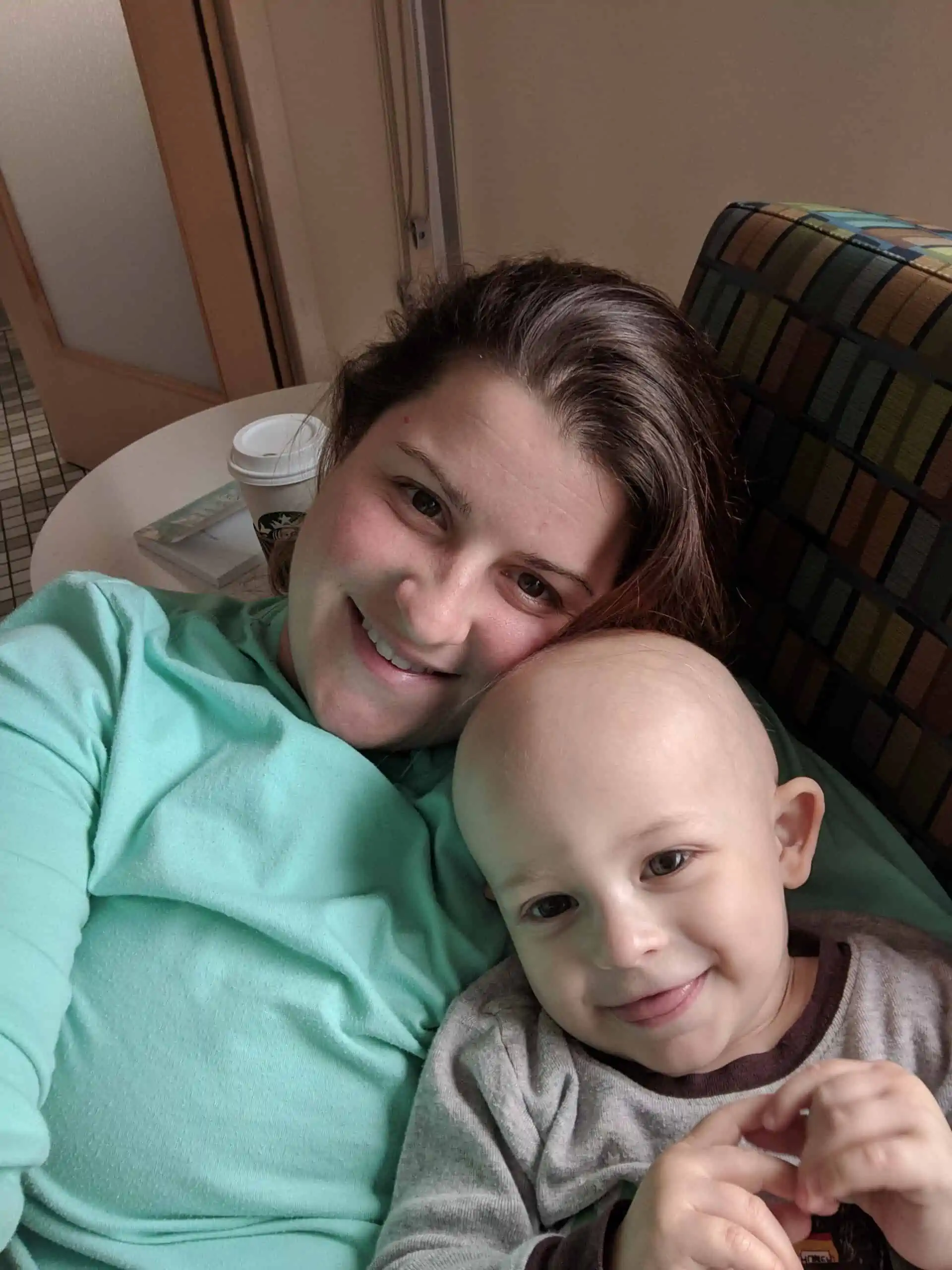
Laura Dearing and her son Odin, for whom Chaos Coffee’s Odin’s Viking Brew was named. Courtesy of Chaos Coffee.
Rounding out the top scorers of the darkest-roasted coffees is Colorado-based Desert Sun’s Dark Canyon (91), a blend of Peru, Honduras and Mexico coffees that is sweetly smoky and crisply chocolaty, redolent of a candy apple. Head roaster Brian Gaddy says, “Our roasting philosophy has always leaned toward lighter roasts, so we developed Dark Canyon to be a dark roast that is not too dark. It’s full bodied without being over-roasted, burned or charred. We use light testing to verify the roast level of all our coffees, and it is one of the keys to maintaining a consistent quality coffee. Dark Canyon whole bean should read right around 40 on the Agtron [M-Basic] scale.”
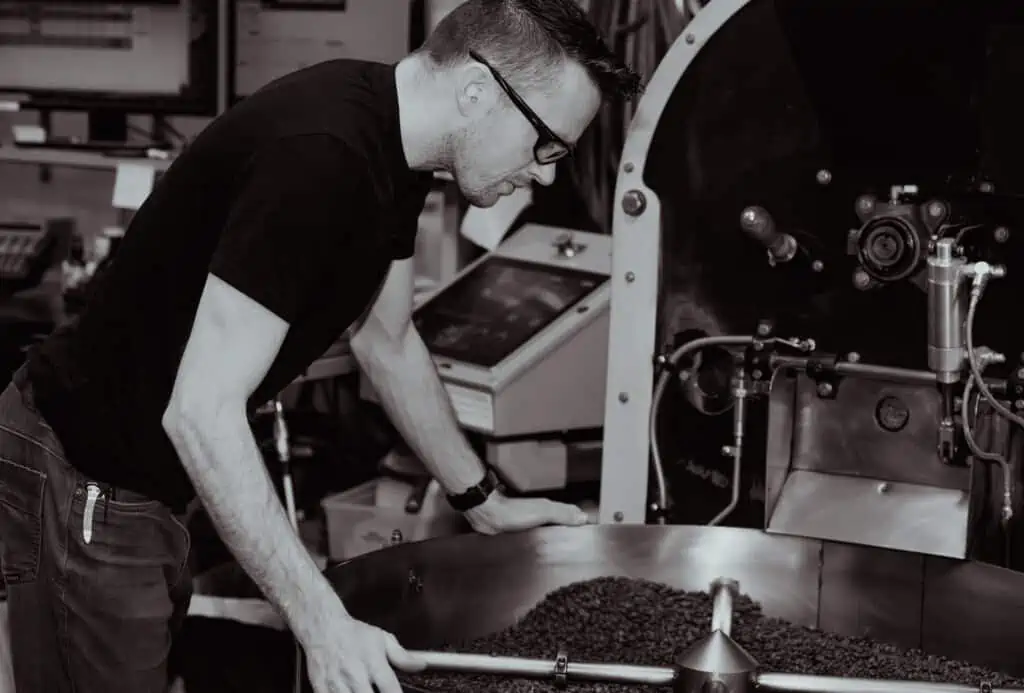
Head roaster Brian Gaddy of Desert Sun Roasters in Durango, Colorado. Courtesy of Desert Sun.
He adds, “I think some people like darker roasts because that’s what they are used to, and they have some nostalgia around them, like, ‘This is what coffee is supposed to taste like.’ Some people don’t want their coffee to be light and bright; some people want a full-bodied, deep, dark coffee experience, and we have something really wonderful for those people.”
We were delighted to find that the darker-roasted coffees of today are not at all homogenous but rather wide-ranging in their sensory appeal. If you’re usually a light-roast drinker, take some of these coffees for a spin, and let us know what you think. Happy exploring!










